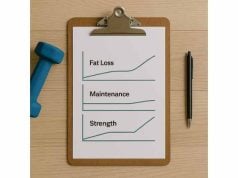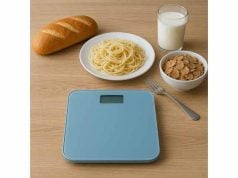
You finished a fat-loss phase and want to keep what you earned—without feeling stuck in “diet mode.” Reverse dieting is a structured way to bring calories back up, stabilize weight, and restore energy while keeping guardrails in place. In this guide, you will learn how to set maintenance targets, raise calories in planned steps, and use weekly data to stay inside a realistic weight band. If your scale has been flat or noisy and you are unsure what to fix first, start with our concise plateau troubleshooting overview, then come back here to build your exit plan.
Table of Contents
- Reverse dieting explained
- Step by step plan first 8 weeks
- Macros during reverse dieting
- Track trends and interpret changes
- Troubleshooting and adjustments
- Safety and who should avoid
- Alternatives and evidence snapshot
- FAQ
Reverse dieting explained
What it is. Reverse dieting is a time-boxed calorie increase after a deficit. You raise intake in small, planned steps, watch the weekly trends (weight, waist, hunger, training), and stop once you are maintaining within a defined band. Think of it as a structured on-ramp out of the cut—not a license to eat freely.
What it is not. It is not magic metabolism repair, and it is not required for everyone. Some people can jump directly to a solid maintenance estimate and hold steady. Others prefer a gradual climb because it helps appetite and routine normalize without big jumps on the scale.
Who benefits most.
- You ended the cut tired, hungry, and restless at night.
- You tended to overeat on weekends when structure loosened.
- You want psychological traction—seeing small, controlled increases beats a sudden jump.
The working targets.
- Weight band: hold your 7-day average within ±0.5–1.0% of your “end-of-cut” average.
- Waist: stable within ±0.5–1.0 cm week to week.
- Performance: gym loads or endurance pace steady or improving.
- NEAT: steps at or above a personal floor (many do well at 7–10k/day).
Why the scale may tick up early. When calories rise, carbs and sodium usually rise too. Glycogen stores refill, and body water goes with them. A 0.5–1.5% bump across a few days is common and not body fat. Judge by averages and waist, not single mornings.
Mindset rules.
- Use guardrails rather than strict rules (protein at each meal, a planned evening snack, post-meal walks).
- Evaluate in two-week blocks—adjust only after you have enough data.
- Keep your plan boringly simple so it survives busy weeks.
If you need a refresher on the fundamentals that made your cut work, skim our overview of healthy weight loss basics before you build maintenance on top of them.
Step by step plan first 8 weeks
This eight-week template shows you how to raise calories, when to pause, and what to track. Use it as written, or slow it down if you prefer smaller steps.
Before you start (Day 0)
- Set your weight band (±0.5–1.0%).
- Record your 7-day average, waist, step floor, and training baseline.
- Choose 3–5 guardrails: protein each meal (25–40 g), vegetables twice per day, 3×10-minute post-meal walks, a 150–250 kcal planned night snack, and the restaurant rule of one (drink or dessert or richer sides).
Week 1: The first increase
- Add +150–250 kcal/day (often +25–40 g carbs and +5–10 g fat).
- Keep protein high and consistent.
- Keep your guardrails visible: default breakfast and lunch, evening snack pre-decided.
- Expect the water/glycogen bump; watch averages, not single days.
Week 2: Verify or pause
- Compare two 7-day averages and your waist.
- If weight and waist are inside your bands, proceed.
- If averages climb >1.0% and waist rises, trim back 100 kcal and hold.
- If averages drop >0.5% with high hunger or flat training, add +100 kcal.
Weeks 3–4: Build to maintenance
- Add another +100–150 kcal/day in Week 3.
- Optional in Week 4: add +50–100 kcal/day if you are still a bit below maintenance and energy feels low.
- Place 20–50 g carbs around training and dinner to curb evening appetite and support performance.
- Keep steps at or above your floor.
Weeks 5–6: Hold and refine
- Hold calories.
- Evaluate satiety and performance; move 10–20 g protein to dinner if evenings are snack-prone.
- If weekends drift, reinstate default breakfasts and post-meal walks.
Weeks 7–8: Confirm maintenance
- Maintain calories inside a ±150–200 kcal band.
- Keep your weekly check-in: 7-day weight average, waist, step average, training note.
- If you want a clearer maintenance target with examples, use our practical method to find maintenance calories and confirm your number.
Stop rules (end earlier if met)
- You have two stable weeks inside your bands.
- You feel energetic, sleep well, and training is steady.
- Hunger is manageable with your guardrails.
Macros during reverse dieting
Calories set the destination; macros determine how comfortable you feel as you climb. Use these ranges, then personalize with quick experiments.
Protein: your anchor
- Target 1.6–2.2 g/kg/day, split over 3–5 meals.
- Practical split: 30–40 g at breakfast and lunch, 35–45 g at dinner, 15–25 g in a planned snack if needed.
- Easy sources: skyr/Greek yogurt, cottage cheese, eggs, tofu/tempeh, fish, chicken, lean beef, edamame, whey or casein.
Carbs: fuel and calm
- Pre-workout: 20–40 g for energy.
- Post-workout: 40–60 g to refill glycogen and blunt cravings.
- Dinner: 30–60 g improves satiety and sleep for many.
- Choose mostly whole-food carbs; keep a few quick options (rice cups, oats, whole-grain wraps) for busy days.
Fats: floor for hormones and flavor
- Keep 0.6–1.0 g/kg/day.
- Use olive oil, nuts, seeds, avocado, and quality dairy to make meals satisfying without overshooting calories.
Fiber: quiet appetite control
- Aim 25–40 g/day, with 8–12 g in your final meal if nighttime snacking is your weak spot.
- Rotate legumes, vegetables, berries, oats, whole grains, and potatoes with skin.
Two-week macro experiments
- Dinner protein up: add +10–15 g at dinner and rate evening hunger and sleep for 14 days.
- Carbs to training: move 30–50 g from mid-day to pre/post-workout and track performance.
- Fiber at night: add 8–12 g to dinner and count late-night snack episodes.
Keep only what made you feel better and kept averages steady. For menu templates and target ranges by body size, see our practical overview of maintenance macros.
Track trends and interpret changes
Reverse dieting works best with simple, repeatable data. Ten minutes per week is enough if you measure the right things and interpret them correctly.
Your four weekly metrics
- Weight trend: daily morning weigh-ins → 7-day average.
- Waist or navel: once weekly, same spot and posture.
- Step average: compare to your floor.
- Training quality: best set or pace, or a 1–10 effort score.
How to weigh without second-guessing
- Weigh daily, after the bathroom, before food.
- Log sodium or unusually late meals—context explains spikes.
- Judge only by the 7-day average and the two-week trend.
What normal looks like
- A 0.5–1.5% weight rise the first week from glycogen/water.
- Waist stable or up ≤0.5 cm with that water bump.
- Steps and training feel better as calories climb.
When to act
- Weight average up ≥1.0% for two weeks and waist up ≥1.5 cm → you likely overshot; trim 100–150 kcal/day.
- Weight average down ≥0.5% with high hunger or flat training → add 100–150 kcal/day.
- Steps >1,500/day below your floor for two weeks → reinstall post-meal walks before changing calories.
If the scale often confuses you, our straightforward daily weigh-in protocol shows how to get honest trends from noisy numbers.
Troubleshooting and adjustments
Even with a good plan, life gets messy. Use these small, time-boxed changes when your data hits a trigger.
Problem: evening overeating during the climb
- Add satiety to dinner: +10–20 g protein, +8–12 g fiber.
- Pre-decide a snack: 150–250 kcal, protein-forward (skyr with fruit, cottage cheese and tomato, protein pudding and kiwi).
- Walk 10 minutes after dinner to reduce restlessness.
Problem: weight trend rises beyond band
- Confirm steps and sodium were consistent.
- Trim 100–150 kcal/day from oils, sweets, or alcohol; keep protein.
- Hold for 14 days; reassess two 7-day averages.
Problem: training stalls despite higher calories
- Shift 20–40 g carbs into the pre/post-workout window.
- Add 250–500 ml fluid and a pinch of salt before long sessions.
- Sleep target 7–9 hours; if short, hold calories and fix recovery first.
Problem: weekends erase weekday stability
- Keep anchor breakfast both days (protein + fruit + grain).
- Schedule a 2-hour movement window across the weekend (walks, chores, playground).
- At restaurants, use the rule of one (drink or dessert or richer sides).
If you need to move the dial more directly—for example after two missed targets in a row—use our tight guide on how to adjust calories and macros without overcorrecting.
Time-boxing keeps changes honest
- Make one change at a time.
- Run it for 14 days, then decide with data, not mood.
Safety and who should avoid
Reverse dieting is a behavioral tool, not a medical treatment. For most healthy adults, a gradual calorie increase with high-protein, high-fiber meals is safe. Still, some situations deserve medical input or an alternate approach.
Talk to your clinician first if you:
- Take medications that affect appetite, glucose, or fluid balance (e.g., insulin, sulfonylureas, antipsychotics, certain antidepressants, corticosteroids, or GLP-1/GIP agonists).
- Have a history of disordered eating or current symptoms of binge-restrict cycles.
- Are pregnant, breastfeeding, or recovering from an illness or surgery.
- Have uncontrolled hypertension or edema where rapid changes in sodium or carbs may shift body water noticeably.
Adjust the plan for these cases
- Medication-related appetite changes: hold smaller calorie steps (+50–100 kcal) and use tighter guardrails (planned snacks, higher dinner protein).
- Very low BMI or underfueling signs: reverse more quickly toward a clinician-set maintenance to restore energy and cycle function.
- Endurance blocks: place more carbs near training; keep a steady sodium plan to avoid confusing water swings.
For common prescription culprits that influence weight and appetite—and the right questions to bring to an appointment—review our quick primer on medications and plateaus before you decide how fast to climb.
Alternatives and evidence snapshot
Straight to maintenance. Many people can jump from their final deficit to a good maintenance estimate and do well. This suits those who tolerate change without anxiety, already eat plenty of protein and fiber, and have stable routines and weekends.
Diet breaks vs. reverse dieting. Diet breaks are planned weeks at maintenance during a long cut to reduce fatigue. Reverse dieting happens after the cut. If you ended your fat-loss phase with a diet break, you may need fewer reverse steps because appetite and training already improved.
Refeeds. One- or two-day higher-carb refeeds can help adherence during deficits but do little for post-diet stabilization. At maintenance, refeeds become ordinary flexible days within your ±150–200 kcal band.
What the evidence supports. Short-term increases in carbs and sodium raise glycogen and water, explaining the early weight bump. High-protein, higher-fiber diets support satiety and weight stability. The rest is behavioral: guardrails, consistent movement, and weekly check-ins catch drift early. Reverse dieting does not “repair” metabolism; it gives you a predictable ramp to the intake you can maintain.
How to choose. If you like clear structure, prefer smaller changes, or struggle with weekends, run the eight-week reverse. If you are confident with maintenance habits, go directly to your estimate and use the same weekly check-ins and guardrails to stay in your band.
FAQ
How fast should I raise calories after a cut?
Start with +150–250 kcal/day in Week 1, then adjust by ±100–150 kcal based on two weeks of weight and waist trends. If energy is low and hunger stays high, add another +100 kcal and reassess with your weekly averages.
Will I gain fat during reverse dieting?
Not if you stay within a ±0.5–1.0% weight band and keep your waist stable. A small early bump is usually water from glycogen. Use two 7-day averages and your waist to judge progress rather than single weigh-ins.
How much protein should I eat at maintenance?
Keep protein high—1.6–2.2 g/kg/day, split across 3–5 meals. Many do well with 30–40 g at breakfast and lunch, 35–45 g at dinner, and 15–25 g in a planned snack. Protein steadies appetite and helps maintain lean mass.
Do I need to track every calorie forever?
No. Track closely for the first 4–8 weeks while you confirm maintenance. Keep a weekly check-in (weight averages, waist, steps, training). When trends are steady, shift to lighter tracking with default meals and occasional audits.
What if weekends keep pushing me over?
Keep an anchor breakfast, schedule a 2-hour movement window, and use the restaurant rule of one (drink or dessert or richer sides). Pre-plan a 150–250 kcal protein-forward snack for evenings. Reassess weight and waist after two weeks.
When should I stop increasing calories?
Stop when you have two stable weeks inside your maintenance band, with good energy and performance. If your 7-day average and waist climb beyond thresholds for two weeks, pause or trim 100–150 kcal/day and retest.
Is reverse dieting necessary for everyone?
No. It is a tool, not a requirement. If you handle change well and already have strong maintenance habits, go straight to a maintenance estimate and monitor with weekly data. Use reverse steps if you prefer smaller, predictable changes.
References
- Systematic review and meta‐analysis of protein intake to support muscle mass and function in healthy adults 2022 (Systematic Review)
- Muscle Glycogen Assessment and Relationship with Body Hydration Status: A Narrative Review 2022 (Review)
- Cereal Fibers and Satiety: A Systematic Review 2025 (Systematic Review)
- The Effects of Intermittent Diet Breaks during 25% Energy Restriction on Body Composition and Resting Metabolic Rate in Resistance-Trained Females: A Randomized Controlled Trial 2023 (RCT)
- 9. Pharmacologic Approaches to Glycemic Treatment: Standards of Care in Diabetes-2025 2025 (Guideline)
Disclaimer
This guide provides general education about post-diet transitions and reverse dieting. It is not a substitute for personalized medical advice, diagnosis, or treatment. If you take prescription medications, have chronic conditions, are pregnant or breastfeeding, or have a history of disordered eating, consult your clinician or a registered dietitian before changing your nutrition plan.
Share and follow
If this step-by-step helped you exit your cut with confidence, consider sharing it with someone starting maintenance. For practical templates and future updates, follow us on the social platform you use most—Facebook, X (formerly Twitter), or any network you prefer.










